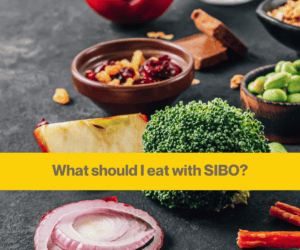Are you sick of fighting bloating, discomfort, and the confusing world of SIBO diet recommendations all the time?
Making the correct dietary decisions can help you win the day.
However, figuring out the complicated world of nutrition can be difficult, particularly for people who have long-term medical issues like SIBO (small intestinal bacterial overgrowth). With so much conflicting and confusing nutritional advice accessible, many people are left wondering which course of action is best for their particular set of health demands.
The best SIBO nutritionist in Bangalore is aware of these difficulties. Over 20,000 people have benefited from our dedication to providing knowledgeable, scientifically supported nutrition counseling, which has helped them achieve their weight goals, manage chronic health issues, and enhance their overall health.
Our SIBO nutrition specialists have worked hard to create this article, which provides a thorough guide on managing SIBO with dietary modifications. Start your journey to a happy, healthier gut by diving into our guide!
Understanding SIBO
Small Intestinal Bacterial Overgrowth occurs when there’s an abnormal increase in the small intestine’s number or types of bacteria. Usually, the small intestine has relatively low levels of bacteria compared to the colon. However, when bacteria from the colon migrate upward or when there’s an imbalance in the gut micro biota, it can lead to SIBO. This overgrowth interferes with normal digestion and nutrient absorption, causing symptoms like bloating, gas, diarrhea, constipation, and abdominal pain.
Our SIBO nutritionist in Bangalore is knowledgeable about SIBO’s nuances. Achieving good management starts with education. Our methodology involves investigating the ‘why’ behind each dietary suggestion rather than just listing foods to consume or avoid. It’s essential to know how certain diets can impact the bacterial balance in your stomach. You can improve gut health and reduce symptoms by making well-informed food decisions.
Diet is key to controlling SIBO; some foods are known to worsen symptoms, while others support a better bacterial balance. Understanding how nutrition affects SIBO and making the necessary adjustments can revolutionize the illness’s management.
10 Ways to Manage SIBO with Dietary Choices
1. Low-FODMAP Diet
Carbohydrates known as FODMAPs (Fermentable Oligosaccharides, Disaccharides, Monosaccharides, and Polyols) ferment in the stomach, causing gas and bloating. For many SIBO sufferers, reducing their intake of fructose-containing meals can help alleviate symptoms. Steer clear of wheat, garlic, onions, certain fruits, and legumes.
2. Limit High-Fiber Foods
While fiber is typically beneficial for digestive health, those with SIBO may find high-fiber foods exacerbate their symptoms. Fiber-rich foods such as beans, lentils, and certain grains can feed the bacteria in the small intestine, worsening bloating and discomfort.
3. Focus on Well-Cooked Vegetables
Opt for well-cooked vegetables over raw ones. Cooking vegetables breaks down some of the fibers and makes them easier to digest, reducing the likelihood of exacerbating SIBO symptoms.
4. Lean Proteins
Incorporate lean proteins like chicken, fish, and tofu into your diet. In contrast to fatty or highly processed meats, which can worsen digestive distress, these proteins are easier to digest.
5. Healthy Fats in Moderation
While healthy fats are essential to any balanced diet, those with SIBO should consume them in moderation. Excess fat can cause discomfort and slow down digestion. Choose healthy sources such as nuts, seeds, and avocados, and pay attention to portion amounts.
6. Probiotic-Rich Foods
Introduce probiotic-rich foods like yogurt, kefir, and sauerkraut into your diet. Probiotics can aid in reestablishing the gut microbiota’s equilibrium, which is frequently upset in SIBO patients.
7. Herbal Teas
Herbal teas such as ginger, peppermint, and chamomile can help soothe the digestive system and alleviate symptoms of bloating and discomfort associated with SIBO.
8. Limit Sugary Foods and Beverages
Sugar can fuel bacterial overgrowth in the small intestine, increasing symptoms. Limit sugary foods and beverages, including desserts, candies, and sweetened drinks.
9. Gluten-Free Grains
For individuals with SIBO, gluten can be particularly problematic. Opt for gluten-free grains like rice, quinoa, and oats to reduce inflammation and improve digestive symptoms.
10. Hydration is Key
Staying hydrated is essential for supporting digestion and overall gut health. Aim to drink plenty of water throughout the day to help flush out toxins and keep the digestive system functioning optimally.
Conclusion
Managing Small Intestinal Bacterial Overgrowth (SIBO) requires a holistic approach encompassing dietary changes, lifestyle adjustments, and professional guidance. Understanding the importance of foods to eat and avoid can significantly alleviate symptoms and promote gut health. The insights provided by the best SIBO nutritionist in Bangalore underscore the significance of personalized dietary plans tailored to individual needs.
Individuals with SIBO can experience relief and improved quality of life by incorporating specific foods that aid digestion, reduce inflammation, and discourage bacterial overgrowth. Avoiding foods that exacerbate symptoms and contribute to a bacterial imbalance within the small intestine is equally vital.
Through education, awareness, and ongoing support, individuals can confidently navigate the complexities of SIBO management. It’s crucial to recognize that managing SIBO is a journey that may require patience and experimentation to find what works best for each person.
Ultimately, prioritizing gut health and adhering to a well-balanced diet can serve as pillars of support in managing SIBO effectively. With the guidance of qualified professionals and a commitment to self-care, individuals can reclaim control over their digestive wellness and embrace a life of vitality and balance.

As the editor of the blog, She curate insightful content that sparks curiosity and fosters learning. With a passion for storytelling and a keen eye for detail, she strive to bring diverse perspectives and engaging narratives to readers, ensuring every piece informs, inspires, and enriches.









